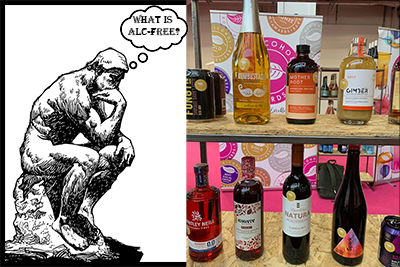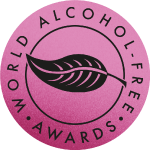Why UK shift on 'alcohol-free' could help everyone
28 September 2023
What exactly is alcohol-free? It might sound like a trick question, in fact it’s anything but. There are multiple descriptors – non-alcoholic, de-alcoholised and low-alcohol as well as alcohol-free - and they kick in at different levels from country to country.
In France and Italy, alcohol-free starts below 1.2% ABV, in Spain it’s 1%. In the rest of the EU it’s 0.5%. To be called alcohol-free Dutch-produced beer needs to be below 0.1%, whereas imported wines in the country need only be 0.5%. In the US drinks below 0.5% are described as ‘non-alcoholic’, not ‘alcohol-free’.
In the UK current guidelines suggest alcohol-free be used below 0.05%, with ‘low alcohol’ below 1.2%. Wines at or below 0.5% are supposed to be called ‘de-alcoholised’.
The situation, in short, is a mess, as legislators round the world struggle to get their head around a category that barely existed ten years ago, but which analysts GlobalData now put at being worth over $10bn - and which is growing fast.
Which is why the decision by the UK government to consider introducing a new, simplified system – as announced today – is so welcome.
Under the proposals, the government is looking at increasing the ‘alcohol-free’ descriptor from its existing level of 0.05% to take in any drinks at or below 0.5% ABV. This, they believe, will make the category easier to understand, the drinks more popular and encourage healthier drinking.
‘It's a really exciting opportunity for the government to put its weight behind a British success story and support its low and alcohol-free producers,’ says Laura Willoughby, founder of the alcohol-free specialist retailer, Club Soda. ‘The sector needs to be liberated from old fashioned and confusing terms.’
Marcos Salazar, head of the international AF group, the Adult Non-Alcoholic Beverage Association also praised the move saying it is ‘essential that there is consistency between the UK, European, and other international markets in terms of labelling.’
In other words, there is very real hope that, should the suggested new alcohol-free definition be approved in the UK (to bring it into line with most of Europe) it could herald the start of some much-needed worldwide consistency.
Playing catch-up
In a sense, the legislators are playing catch-up here, because most in the alcohol-free industry work to this level in any case. It’s a de facto globally-accepted standard, even if the legislation around it hasn’t kept up.
It’s what most producers, retailers and hospitality providers mean when they talk about alcohol-free, and it’s the reason why this competition, the World Alcohol-Free Awards, set 0.5% ABV as its benchmark.
Jérome Cuny runs an alcohol-free bar in Nantes, France. ‘Most of the producers [in France] are making 0.5% or less in order to be able to export,’ he says. ‘And most of my customers ask for 0.0 or 0.5 or less.’
In other words, while ‘alcohol-free’ in France might permit twice that amount of alcohol, the market is setting its own rules.
From a production point of view, 0.5% has many advantages.
‘0.5% may only be a trace of alcohol but it makes all the difference to taste,’ says Rob Fink, founder of Big Drop. ‘All 0.0% beers have had the alcohol removed. A 0.5% beer, however, has been naturally brewed using traditional methods and the end result is a beer so good you won’t miss the alcohol.’
It can also help de-alcoholisers to be able to blend back in a small amount of the original product.
‘If we can allow 0.5% alcohol in the product we can preserve the essence of the wine/spirit/beer and add it back, so it is more flavourful and more natural,’ says Irem Eren, business development manager at de-alcoholisation specialists, BevZero.
In other words, 0.5% ABV is seen as the sweet spot. It’s an area where it’s significantly easier to attain flavour and balance in the finished drink, making it easier for people to switch over from alcoholic drinks, while not being intoxicating.
Helping consumers into the category
The UK’s Wine and Spirit Trade Association believes that simplifying the sector by labelling anything at or under 0.5% ABV ‘alcohol-free’ would ‘encourage healthy drinking habits before harmful ones are formed’ and government seems to agree.
‘Liberalising labelling guidelines could also help people make more informed choices about the drinks they buy,’ said public health minister, Neil O’Brien.
‘We want to encourage the growth of no and low alcohol alternatives for those looking to moderate their alcohol intake.’
This doesn’t sound controversial, but the move towards ‘0.5% = alcohol-free’ is not without complications. For instance, those looking for complete absence of alcohol – whether for religious or health reasons – might find the term misleading.
Tim Blake, founder of Crossip, suggests something like a kite-mark, stating whether a product has used alcohol in the production process or not.
The UK health body Alcohol Change UK favours a four-tier system of descriptors starting with Zero (0.0%), Alcohol-free (<0.05%), Super/ultra-low (<0.5%) and Low-alcohol (0.5-1.2%).
A more segmented approach might help to head off problems such as that in the US two years ago, when a Louisiana woman sued Heineken over the fact that the brewer’s ‘alcohol-free beer’ actually contained 0.03% alcohol.
But to those in the world of alcohol-free, this seems unnecessarily convoluted, particularly given how poorly understood alcohol levels are in the first place.
Recent research by Toluna/Harris Interactive suggested that 20% of consumers think that wine starts at 5% ABV, and spirits at 12%. So having four categories between 0% and 1.2% could actually confuse the public and discourage them from positive behaviour (drinking less) that both governments and the medical profession want to see more of.
‘We need to promote choice and make sure the consumer has as much variety in low and alcohol free drinks as they do full strength drinks,’ says Club Soda’s Laura Willoughby. ‘Many food and drink items we consume every day contain a trace element of alcohol and alcohol-free drinks should not be treated differently.’
For more articles like this click here to go to the AF World section of the World Alcohol-Free Awards website. For results from the inaugural competition click here.


